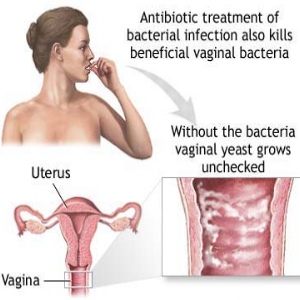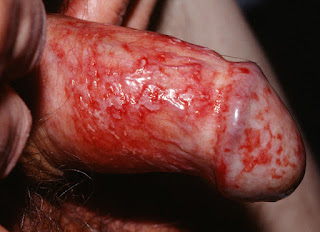Nearly 75% of all adult women have had at least one "yeast infection" in their lifetime. On rare occasions, men can also get genital candidiasis. VVC occurs more frequently and more severely in people with weakened immune systems. Other conditions that may put a woman at risk for genital candidiasis include pregnancy, diabetes, long-term use of broad-spectrum antibiotics or use of corticosteroid medications.
Some of the signs of a yeast infection are itching, burning or swelling in and around the affected area. If it is a vaginal yeast infection, there will be pain or discomfort in the vagina during sex, a burning feeling when urinating, and odorless vaginal discharge. There are many simple home remedies that can eliminate the infection in a relatively short time. A vaginal yeast infection means that too many yeast cells are growing in the vagina . These infections are very common. Although they can bother you a lot, they are not usually serious. And treatment is simple.
 |
| Yeast Infections In Women |
Yeast Infections In Women
Women can also get yeast infections after menopause due to declining estrogen levels, which thin the vaginal walls. Most men and women suffer from a yeast infection at least once. |
| Yeast Infections In Men |
Yeast Infections In Men
Although uncommon, men can get a yeast infection by having unprotected sex with a woman with candidal vaginitis. It usually appears as small white spots, redness, or a dry, peeling rash on the penis accompanied by itching, irritation, or burning. Men who have not been circumcised are at an increased risk. |
| Yeast Infections In Babies |
Yeast Infections In Babies
Everyone has harmless amounts of yeast (Candida) in and on their body. It's actually a fungus and thrives in warm, wet places like the mouth, bowels, skin, and vagina. Even if your child is a boy, the moist environment of a wet diaper can easily cause a yeast infection – especially if there's already an untreated diaper rash. Babies taking antibiotics and breastfed babies whose mothers are on antibiotics are also more susceptible to yeast infections. That's because antibiotics kill the good bacteria in the body that keep yeast in check. Without these bacteria around, yeast can grow more abundantly. If your child recently had thrush (a yeast infection of the mouth), he may end up with a yeast infection in his diaper area, too. Yeast passes through your child's digestive system when he eats and it ends up in his stool, which eventually lands in his diaper right next to his warm, damp skin. |
| Yeast Infection In Pregnancy |
Yeast Infection In Pregnancy
Yeast infections during pregnancy are more common than any other time in a woman's life, especially during the second trimester of pregnancy. You may be noticing an increase in the amount of thin, white, odd smelling discharge. This is common and a normal symptom in the second trimester. If you think you may be experiencing a yeast infection, the following information will prepare you to discuss the possibility with your doctor. Though yeast infections have no major negative effect on pregnancy, they are often more difficult to control during pregnancy causing significant discomfort for you. Don't waste time in seeking treatment.Causes of a yeast infection
Common yeast infections are caused by the yeast species Candida albicans. However, there are other species of Candida which can cause an infection and may, at times, require different treatments.Balanced levels of yeast and bacteria are normally present in a woman's vagina; however, disturbances in this delicate balance can lead to the development of an infection.
Normally, the bacteria Lactobacillus creates an environment that does not encourage yeast overgrowth. However, at times, yeast will become dominant and cause symptoms of a yeast infection.
Yeast infections of the vagina are not sexually transmitted diseases; however, they can be spread through oral-genital contact or during intercourse.
There are certain factors that increase the risk of developing a vaginal yeast infection; these include:
- Use of antibiotics and/or corticosteroids
- Pregnancy
- Uncontrolled diabetes
- Being immunocompromised
- Any scenarios that can cause changes in normal vaginal flora, including douching
Symptoms of a yeast infection
A yeast infection causes itching or soreness in the vagina and sometimes causes pain or burning when you urinate or have sex. Some women also have a thick, clumpy, white discharge that has no odor and looks a little like cottage cheese. These symptoms are more likely to occur during the week before your menstrual period.Yeast infection symptoms can range from mild to moderate and include:
- Itching and irritation in the vagina and the tissues at the vaginal opening (vulva)
- A burning sensation, especially during intercourse or while urinating
- Redness and swelling of the vulva
- Vaginal pain and soreness
- Vaginal rash
- Watery vaginal discharge
- Thick, white, odor-free vaginal discharge with a cottage cheese appearance
 |
| Yeast Infection On Skin |
Yeast Infection On Skin
Candidiasis of the skin often causes a red, itchy rash to form, most commonly in the folds of the skin. This rash may also spread to other areas of the body. While the symptoms are often bothersome, they can usually be treated with improved hygiene and antifungal creams or powders. Areas of skin that are moist or sweaty are ideal for candida to thrive. Therefore, the common sites affected are in the folds of skin in your groin, armpits and under large breasts. Nappy rash is sometimes due to candida. Obese people may develop candidal infection between folds of skin. It can also affect skin between your fingers and toes and at the corners of your mouth. |
| Yeast Infection On Penis |
Yeast Infection On Penis
While it is more common for women to get yeast infections, it is also possible for men to contract a genital yeast infection, usually after having unprotected sex with a partner who is already infected. The infection usually appears on the skin outside the penis. Penile yeast infections affect men who are uncircumcised more than those who are circumcised. This is because a circumcised penis exposes the glans to air, keeping it dry and cool, while yeast requires heat and moisture to grow and survive.Common symptoms of Yeast Infection On Penis include:
- Burning and itching around the head of the penis
- Redness and swelling
- Small, rash-like bumps called papules, which may have pus
- Pain during urination or sex
 |
| Yeast Infection On Face |
Yeast Infection On Face
Some of the reasons that have often been forgotten to explaining why yeast infection on face appear. In some cases, yeast infections may be due to a low immune system, as the body may not be strong enough to deal with internal aggressions. This can happen when there is a vitamin deficiency in the body. Another cause of yeast infection on face that is rarely discussed is related to acidosis. Acidosis is an excessive acid condition in the body fluids and/or tissues because of renal gland malfunction. It is partially due to eating disorders and nutrition imbalance. As a result, the body is producing a reaction as a signal, which may create a yeast infection on face. |
| Yeast Infection On Thrush, Tongue |
Yeast Infection On Thrush, Tongue
Small amounts of the candida fungus are in your mouth, digestive tract, and skin. It's supposed to be there, and it's usually kept under control by the other bacteria in your body. But sometimes, certain illnesses or medications, like corticosteroids or antibiotics, can disturb the balance. This can cause the fungus to grow out of control. That's when you get thrush. |
| Yeast Infection On Breast |
Yeast Infection On Breast
Pain during breastfeeding is a common reason for mothers to wean. By helping mothers seek relief of symptoms and treatment for the yeast, Leaders can help preserve breastfeeding relationships. Often you only need make a few minor adjustments in technique or style to get your body and your baby in perfect sync. "Breastfeeding should be a pleasurable experience for both mother and baby. If it's not, then it's important to identify the problem early on and make whatever changes are necessary," says Pat Sterner, a lactation counselor at the Mount Sinai Medical Center in New York.Some predisposing factors to mammary candida are:
- Baby who has been diagnosed with thrush, or fungal diaper rash
- Previous history of vaginal yeast infections
- Recent antibiotic therapy
- Nipple damage
- Heavy consumption of dairy products, heavily sweetened foods and/or artificial sweeteners
- Recent use of corticosteroid therapy
No comments:
Post a Comment